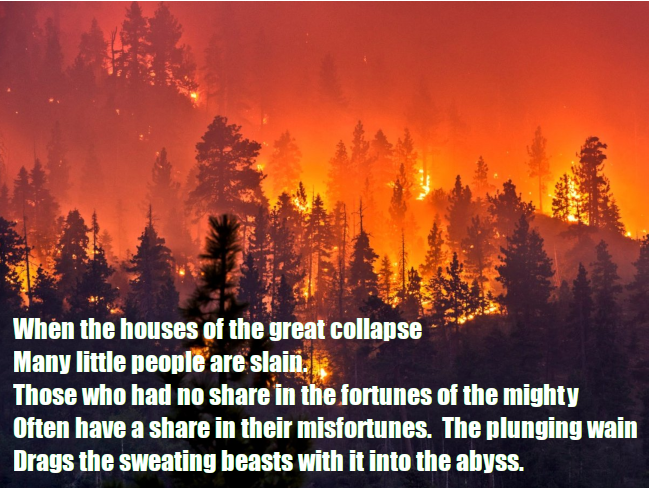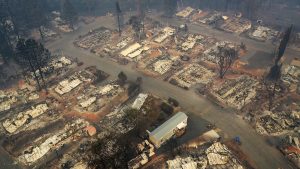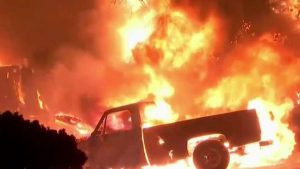Ansar Fayyazuddin
November 22, 2018

The California wildfires raging in the north and the south of the state have left such horrific devastation in their wake that biblical metaphors of disaster come easily to mind. “Armageddon” and “inferno” appear regularly as descriptors in newspaper accounts of the disaster. The photographic images of the aftermath of these wildfires recall destruction wrought by aerial bombing and scorched earth warfare but resemble most closely the iconography of post-apocalyptic cinema and therefore of fiction. The loss of human life is staggering in number and the manner heart-sickening.
The Camp Fire in the north and the Woolsey Fire in the south of California are the latest wildfires that continue to wreak devastation. As of this writing, Camp Fire has resulted in at least 79 deaths, 10,623 destroyed homes, the scorching of 150,000 acres of land and 5 injured firefighters. The Woolsey Fire burning in Los Angeles and Ventura counties, has already resulted in at least 3 deaths and the destruction of 1400 homes and businesses (LA Times 11/19).
Numbers are good starting points but they cannot capture the trauma and horror of what is transpiring. On their own, they also cannot tell the story of the failures of local, state and federal governments in preventing or mitigating these horrific tragedies. Natural disasters are only partially “natural”. They are rarely singular and their predictable recurrence is matched only by the equally predictable failure to prepare for them.

These disasters have a way of laying bare not only the physical mechanisms of natural phenomena but also the priorities of our economic system as well as the underlying social hierarchies and systems of injustice that remain hidden in the routine of everyday life.
Natural disaster?
California wildfires are both natural and unnatural and it is helpful to pick apart and examine these different aspects. Wildfires are fires propagated through wild vegetation. California wildfires are seasonal and occur during periods when the wild greenery is sufficiently dry to be able to sustain fires. Winds, which themselves have seasonal and, overall, predictable patterns, propel the fires along paths of favorable terrain. Due to seasonal patterns of rainfall in California, the driest periods are the most prone to wildfires. Late summers tend to be when the wildfire season begins and it is typically over by November when rains start to fall. Wildfires are a natural part of the ecology of California and their location and paths are well known.
Despite the predictable paths of California wildfires, developments of towns and places of residence in these wildfire corridors continues. The towns of the poor and the rich may both lie in these well-worn paths of wildfires but for historically distinct reasons. The examples of Paradise and Malibu are instructive.
In the overheated real estate market of California, poor and working people are often priced out or otherwise forced out of their homes to seek cheaper abodes elsewhere. The inhabitants of Paradise, a town of 27,000 eviscerated by Camp Fire, are an example of such a low-income community with many of them living in mobile homes. Paradise is in Butte county and has a long history of fires. According to an LA Times report (11/13/2018), it experienced massive fires in 1927, 1943, 1951, 1961, 1964, 1990, 1999, 2000 and 2008.
The super-rich in Los Angeles county have also faced destruction of their homes including from the current Woolsey Fire but for quite distinct and independent reasons. Malibu, an emblem of the super-rich, faces wildfires regularly and predictably but remains a great place for real estate investment. Besides access to beaches, Malibu offers significantly cooler temperatures during the dogdays of summer. In the words of Mike Davis, the (by rights) ecologist-laureate of Los Angeles, “stand at the mouth of Malibu Canyon or sleep at the Hotel St. George for any length of time, and you eventually will face the flames. It is a statistical certainty. (p.98, Ecology of Fear (1998)”

The inhabitants of Paradise were forced to evacuate in the face of the encroaching Camp Fire. Many were caught in a death trap as traffic on the roads leading out of Paradise came to a standstill. The evacuation was almost entirely carried out privately by residents but, as recounted in moving accounts of solidarity, many tried to help their neighbors, friends and families flee. California authorities, local and statewide, failed to provide adequate help with the evacuation whether by directing traffic or by providing transportation. The death toll in Paradise continues to rise as the hundreds currently missing are slowly accounted for.
The story of Malibu is starkly different. Mike Davis, in his account of the 1993 Malibu wildfire, wrote, “Defended in 1993 by the largest army of firefighters in American history, wealthy Malibu homeowners benefited as well from an extraordinary range of insurance, landuse, and disaster relief subsidies. Yet, as most experts will readily concede, periodic firestorms of this magnitude are inevitable as long as residential development is tolerated in the fire ecology of the Santa Monicas. (p. 99, Ecology of Fear)” These advantages of the rich continue to the present. As the Guardian reported, insurance companies provide wealthy homeowners with wildfire protection through private firefighting companies that offer prevention services as well as responding when wildfires threaten their property. This time around many Malibu mansions survived thanks to this private service.
Climate change
Adding to the challenges of wildfires, seasonal weather patterns are changing due to climate change. Over the past century, California has warmed by about three degrees Fahrenheit. Most of the state’s hottest and driest years have occurred during the last two decades. That extra-warmed air sucks water out of plants and soils, leaving the trees, shrubs, and rolling grasslands of the state dry and primed to burn. In addition, also due to climate change, rainfalls have been delayed on average—now coming only in November or even December.
The current season of wildfires is part of a record breaking succession, with the previous record set in 2017 which had surpassed a new record, set only in 2015. Climate change appears to be the driving force behind these catastrophic changes.
Beyond death, injury and destruction of property by the fires themselves, the acrid smoke is being carried well beyond the confines of the fires. The smoke poses health risks of its own. Particulate matter in the air has made the air quality so low in many parts of California that residents are encouraged to stay indoors. Amid public health debate about whether or not masks help and who should wear them, it is clear that governments have left people to fend for themselves, rather than making sure that the right kind of masks are available to all who need them. Despite this being a public health problem, there is no public provision of the recommended types of mask.
As Trump deploys over 5,000 troops at the US-Mexico border at a cost of $200 million to illegally prevent a caravan of 4,000 children and adults from seeking asylum in the United States, the fight against wildfires remains in the hands of overstretched firefighters with inadequate resources. Many of the firefighters are inmates of the California prison system and paid $1/hour for the time they spend fighting fires. In interviews conducted by Democracy Now, the inmates describe 20-hour days fighting fires while weighed down by equipment and supplies that include food and water for day-long shifts in the scorching heat. A prison guard described these inmate firefighters as the “backbone” of California’s wildfire fighting strategy.
Nature is not our enemy
Ordinary Californians suffer once again from catastrophic wildfires whose effects on the population could have been mitigated or altogether prevented with planned, affordable and safe housing, adequate resources for firefighting, and public health initiatives. Beyond mitigation, only aggressive action to reduce climate change will prevent these catastrophic wildfires. Nature is not our enemy. We must live in harmony with it or continue to repeat the disastrous tragedies that come with attempting to conquer it.

Comments
One response to “California Wildfire Death and Destruction – 2018 Edition”
What’s the real cause of the California wildfires? Trump says in his brief tweets that it’s because of poor forest management. Mike Davis (@ https://www.lrb.co.uk/…/mike-davis/el-diablo-in-wine-country), one of the most articulate and insightful socialist writers we have today, has made similar points many times, blaming what he calls ‘real estate capitalism’. In October 2017, a year before the current disaters, he said:
“Although the explosive development of this firestorm complex caught county and municipal officials off guard, fire alarms had been going off for months. Two years ago (ie in 2015 – ed.), at the height of California’s worst drought in five hundred years, the Valley Fire, ignited by faulty wiring in a hot tub, burned 76,000 acres and destroyed 1350 homes in Lake, northern Sonoma, and Napa counties.
Last winter’s (2016) record precipitation, meanwhile, did not so much bust the drought as prepare its second and more dangerous reincarnation. The spring’s unforgettable profusion of wildflowers and verdant grasses was punctually followed by a scorching summer that culminated in September with pavement-melting temperatures of 41ºC in San Francisco and 43ºC on the coast at Santa Cruz. Luxuriant green vegetation quickly turned into parched brown fire-starter.” Underlying this is real estate capitalism, “the financial and real-estate juggernaut that drives the suburbanisation of our increasingly inflammable wildlands”.